
15 Dec 2012 02:39:19
In that sense, black holes are neither here nor there. In practical terms, however, these death stars are everywhere and may mean everything to us. There is even a tiny one – a piffling four million times as massive as the Sun – at the heart of the Milky Way, the galaxy we call home. Cambridge scientists announced in October that they had peered through cosmic clouds of dust in the very early universe to identify a new population of supermassive black holes – one of them is 10 billion times more massive than the Sun – at a distance of 11 billion light years. The paradox is that, while the forces within the invisible enclosure of a black hole are so fierce that nothing, not even light, can get out, these dark stars are also the most radiant things in the universe.
A spinning, supermassive black hole is a kind of cosmic-scale battery, says Caleb Scharf: it can produce a pole-to-equator difference of a thousand trillion volts, it can propel the tenuous matter swirling around its devouring maw to relativistic speeds and deliver what is still called a quasar – an electromagnetic outpouring equivalent to the light from 100 billion Suns. It is the most efficient converter of energy in the cosmos.
It can also puff slow, pulsating bubbles of inaudible sound through the vast galactic cloud around it, "57 octaves below B flat above middle C in case you were curious. That's approximately 300,000 trillion times lower in frequency than the human voice … Supermassive black holes can make you a very, very nice sound system."
Scharf heads an astrobiology research team at Columbia University in New York, and his thesis is that the biggest black holes serve as cosmic regulators: that they control the production of stars in the great clouds of gas and dust from which, ultimately, all stars and planets must condense. It could also be the wild card, the joker, the blind, haphazard agency that decides whether a galaxy has any future for photochemistry, organic chemistry, and ultimately, sustained biochemistry on some randomly ordered rocky planet with running water, reasonably near its parent star in some quiet galactic suburb. The Milky Way, says Scharf, is "smack-dab in the sweet-spot of massive supermassive black hole activity. It is possible that this is not mere coincidence."
There are 100 billion galaxies out there in the farthest cosmos, each containing at least 100 billion stars. Some of these are spiral galaxies, and the only life we know about exists on the outer limb of one spiral galaxy with a relatively quiet black hole at its heart. So the argument is tentative: with a sample of one, what else could it be? But that's the allure of cosmology. It offers the ghost of a possibility of an answer to the eternal question: how did we get here?
And once again, this heady story of astronomical endeavour and cosmic conjecture prompts a happy mix of marvels. Consider, for example, the gravitational forces acting on a neutron star, an ultradense object one step from total collapse into a singularity or black hole. To escape from Earth's gravitational field, you need a rocket speed of about eight miles a second. To get away from a neutron star, the rocket must accelerate to 62,000 miles a second. If you dived from a springboard one metre above its surface, you would hit the ground at 1,200 miles a second. Drop into a black hole, however, and you'd slam through the point of no return at virtually the speed of light.
The other paradox of these unimaginable objects is that somebody first had to imagine them. John Michell, a British pioneer of earthquake science in 1783 followed the logic of Newton's theory of gravity and proposed a dark star, a star so massive its own light would return to it. The French mathematician Pierre-Simon Laplace separately arrived at the same reasoning a decade later. Albert Einstein began to explore the way a massive star might distort the fabric of the universe around it. Karl Schwarzschild, a German mathematician and, in 1915, a gunner on the Russian front, worked out the way space and time would be distorted around a massive spherical object. The event horizon, the point beyond which light cannot escape, is now formally called the Schwarzschild radius. This was more than 70 years before a single black hole had been identified.
And that's the other delight of this book, and all such accounts of discovery. They offer a reminder that, given an understanding of mathematical logic and some lenses with which to make a telescope, one accidental species on one inconsequential speck of matter in the 14 billionth year of the universe has been able to identify a few testable laws that govern matter and energy, and from these, and with an arsenal of ever more ingenious telescopes, build up a picture of things that happened far away and long ago, and from that begin to construct a story of everything.
The story is provisional. The next generation of space-based and earth-bound telescopes will almost certainly reveal ever more amazing things, with ever greater precision. Who needs another series of Star Wars movies, when the universal studios can go on delivering excitement on this scale?

